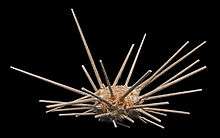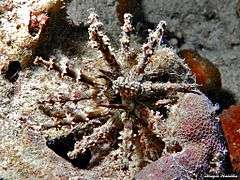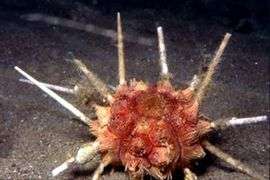Cidaridae
| Cidaridae Temporal range: Lower Permian–Recent | |
|---|---|
 | |
| Cidaris cidaris | |
| Scientific classification | |
| Kingdom: | Animalia |
| Phylum: | Echinodermata |
| Class: | Echinoidea |
| Subclass: | Perischoechinoidea |
| Order: | Cidaroida |
| Family: | Cidaridae Gray, 1825 |
| Genera | |
|
See text | |
Cidaridae is a family of sea urchins in the order Cidaroida.
Description and characteristics
Cidarid sea urchins are characterized by their stout skeletton : the test is thick and hard, with massive perforated tubercles (never crenulated) surrounded by a crown of secondary tubercles, but no primary tubercles in the interambulacra regions. These tubercles hold massive spines, thick, strong and often very long, and showing sometimes odd shapes (thorny spines, fans, clubs, christmas trees[1]...)[2] · .[3]
The order Cidaroida is the basalmost of current sea urchins, and most of the species included in this family are abyssal, even if a handful of species remain quite common in tropical shallow waters, like Eucidaris or Phyllacanthus.
Genera
According to the World Register of Marine Species (WoRMS), the following genera are included in this family [4]
- Subfamily Cidarinae (Mortensen, 1928a)
- Genus Calocidaris (H.L. Clark, 1907)
- Genus Centrocidaris (A. Agassiz, 1904)
- Genus Chondrocidaris (A. Agassiz, 1863)
- Genus Chorocidaris (Ikeda, 1941)
- Genus Cidaris (Leske, 1778)
- Genus Compsocidaris (Ikeda, 1939)
- Genus Eucidaris (Pomel, 1883)
- Genus Hesperocidaris (Mortensen, 1928b)
- Genus Kionocidaris (Mortensen, 1932)
- Genus Lissocidaris (Mortensen, 1939)
- Genus Tretocidaris (Mortensen, 1903b)
- Subfamily Goniocidarinae (Mortensen, 1928a)
- Genus Austrocidaris (H.L. Clark, 1907)
- Genus Goniocidaris (Desor, in Agassiz & Desor, 1846)
- Genus Ogmocidaris (Mortensen, 1921)
- Genus Psilocidaris (Mortensen, 1927)
- Genus Rhopalocidaris (Mortensen, 1927)
- Genus Schizocidaris (Mortensen, 1903b)
- Genus Adelcidaris (Cotton & Godfrey, 1942) (nomen dubium)
- Tribe Phyllacanthina (Smith & Wright, 1989)
- Genus Phyllacanthus (Brandt, 1835)
- Sub-family Stereocidarinae (Lambert, 1900)
- Genus Phalacrocidaris (Lambert, 1902)
- Genus Stereocidaris (Pomel, 1883)
- Subfamily Stylocidarinae (Mortensen, 1903)
- Genus Acanthocidaris (Mortensen, 1903b)
- Genus Plococidaris (Mortensen, 1909)
- Genus Prionocidaris (A. Agassiz, 1863)
- Genus Stylocidaris (Mortensen, 1909)
A now abandoned genus, Cidarites was used in the late 18th and early 19th century to describe a number of species of both cidarid and echid sea urchins.[5]
.jpg)

 Plococidaris verticillata
Plococidaris verticillata Prionocidaris baculosa, from Philippines
Prionocidaris baculosa, from Philippines Chondrocidaris gigantea, from Hawaii
Chondrocidaris gigantea, from Hawaii Stylocidaris affinis
Stylocidaris affinis Eucidaris galapagensis
Eucidaris galapagensis
References
- ↑ Mah, Christopher L. (December 7, 2009). "The Echinoderm Christmas Tree?? Antarctic Cidaroid Sea Urchins!". Echinoblog.
- ↑ Mah, Christopher L. (August 20, 2013). "Strange Urchin Spines! Past and Present!". Echinoblog.
- ↑ Mah, Christopher L. (May 20, 2015). "What is Going on with cidaroid sea urchins and their WEIRD spines??". Echinoblog.
- ↑ WoRMS : Cidaridae
- ↑ "Cidarites auct.". WoRMS. Retrieved 9 April 2013.
- The Echinoid Directory : Taxonomy; Natural History Museum, London
- Description of the Cidaridae; Natural History Museum, London
- Hansson, H.G. (2001). Echinodermata, in: Costello, M.J. et al. (Ed.) (2001). European register of marine species: a check-list of the marine species in Europe and a bibliography of guides to their identification. Collection Patrimoines Naturels, 50: pp. 336–351